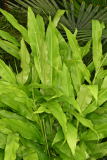Additional notes (click to expand)
Medicinal
In traditional herbal medicine:
It has a bergamot flavour. Used as an ancient medicinal plant in China (vermifuge (earliest recorded), antimalarial, insect-bites, etc.).
Mabberly, D.J., 2006, The Plant-Book, 5 ed., Cambridge University Press, Cambridge p.923
Nomenclature
In the past, ginger with a strong scent was considered male and mioga with a mild scent was considered female, and ginger was called Senoka (elder brother's scent) and myoga was called Menoka (younger sister's scent). It is believed that Menoka passed through the old kana spelling Meuga and then became the modern kana spelling Mioga.
Yutaka Sashida (Doctor of Pharmacy), Professor Emeritus at Tokyo University of Pharmacy and Life Sciences
Yutaka Sashida. Encyclopedia of Plants with Familiar "Scents and Fragrances". BAB JAPAN
There is another popular myth about the origin of the name myoga that still exists today. One of the Buddha's disciples had a bad memory and could not even remember his own name, so he carried a load of his name
written on it on his body. "Carry" means to carry on one's person. The mioga plant was also growing on the grave of
the person when he died, so it was named mioga, and the name was changed to mioga by adding the Kusakanmuri.
Note: Kusakanmuri is a part of Japanese kanji. It means plants. In my opinion, kanji is a bit like Latin.
Yutaka Sashida (Doctor of Pharmacy), Professor Emeritus at Tokyo University of Pharmacy and Life Sciences
Yutaka Sashida. Encyclopedia of Plants with Familiar "Scents and Fragrances". BAB JAPAN
Other use
It has a bergamot flavour. Used as an ancient medicinal plant in China (vermifuge (earliest recorded), antimalarial, insect-bites, etc.).
Mabberly, D.J., 2006, The Plant-Book, 5 ed., Cambridge University Press, Cambridge p.923
The young spring shoots are first picked and then later in the year the slightly scented flower buds are eaten.The flower buds are pickled and used as a spice. The buds are used in mizo soup and tempura.
The flower stalks in Figure 2 have a fragrant, spicy taste and a crunchy texture when bitten, so they are edible under names such as "mioga," "flower myoga," or "child of mioga." They are finely chopped and used as a condiment in various dishes, but because they contain lye, they are soaked in water for a while before using. They are also pickled in sake lees, miso, and used in tempura. The young shoots are also edible under the name "miogatake" because their shape resembles bamboo shoots. It seems that myoga is only edible in Japan.
Yutaka Sashida (Doctor of Pharmacy), Professor Emeritus at Tokyo University of Pharmacy and Life Sciences
Yutaka Sashida. Encyclopedia of Plants with Familiar "Scents and Fragrances". BAB JAPAN
Toxicity
Zingiber officinale contains methyleugenol, an alkenylbenzene. It is carcinogenic and genotoxic in mice. No data on Z.mioga.
van den Berg, S.J.P.L., Restani, et al., P.. (2011). Levels of Genotoxic and Carcinogenic Compounds in Plant Food Supplements and Associated Risk Assessment. Food and Nutrition Science 2: 989-1010.
link
Geographical distribution
- Asia-Temperate, Eastern Asia, Japan
Zingiber mioga (Thunb.) Roscoe
Family: ZINGIBERACEAEGenus: Zingiber
Species: mioga (Thunb.) Roscoe
Common names: Japanese Ginger; Mioga Ginger
Distribution summary: Japan
Habit: Perennial
Hardiness: H5 - Hardy; cold winter
Habitat: Moist woodland and riverbanks
Garden status: Currently grown
Garden location: Far East (L)
Flowering months: August, September, October
Reason for growing: Medicinal, other use
